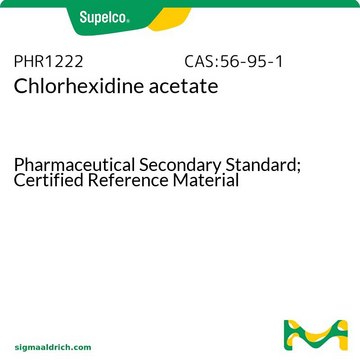1111103
USP
Chlorhexidine acetate
United States Pharmacopeia (USP) Reference Standard
Synonym(s):
Chlorhexidine diacetate salt
About This Item
Recommended Products
grade
pharmaceutical primary standard
API family
chlorhexidine
manufacturer/tradename
USP
application(s)
pharmaceutical (small molecule)
format
neat
storage temp.
2-8°C
SMILES string
Clc1ccc(cc1)N\C(=N\C(=N)NCCCCCCNC(=N)\N=C(\Nc2ccc(cc2)Cl)/N)\N.OC(=O)C.OC(=O)C
InChI
1S/C22H30Cl2N10.2C2H4O2/c23-15-5-9-17(10-6-15)31-21(27)33-19(25)29-13-3-1-2-4-14-30-20(26)34-22(28)32-18-11-7-16(24)8-12-18;2*1-2(3)4/h5-12H,1-4,13-14H2,(H5,25,27,29,31,33)(H5,26,28,30,32,34);2*1H3,(H,3,4)
InChI key
WDRFFJWBUDTUCA-UHFFFAOYSA-N
Looking for similar products? Visit Product Comparison Guide
General description
Application
- Chlorhexidine Acetate Topical Solution
- Chlorhexidine Gluconate Oral Rinse
- Chlorhexidine Gluconate Solution
- Chlorhexidine Gluconate Topical Gel
- Chlorhexidine Gluconate Topical Solution
- Chlorhexidine Hydrochloride
Analysis Note
Other Notes
related product
Signal Word
Warning
Hazard Statements
Precautionary Statements
Hazard Classifications
Acute Tox. 4 Oral - Aquatic Acute 1 - Aquatic Chronic 1 - Eye Irrit. 2 - Skin Irrit. 2 - STOT SE 2
Target Organs
Liver,Teeth
Storage Class Code
11 - Combustible Solids
WGK
WGK 3
Flash Point(F)
Not applicable
Flash Point(C)
Not applicable
Choose from one of the most recent versions:
Certificates of Analysis (COA)
Sorry, we don't have COAs for this product available online at this time.
If you need assistance, please contact Customer Support.
Already Own This Product?
Find documentation for the products that you have recently purchased in the Document Library.
Customers Also Viewed
Our team of scientists has experience in all areas of research including Life Science, Material Science, Chemical Synthesis, Chromatography, Analytical and many others.
Contact Technical Service







